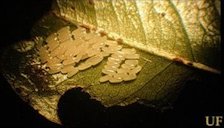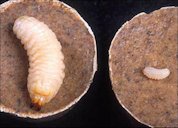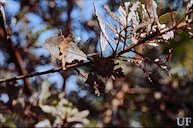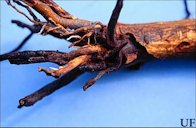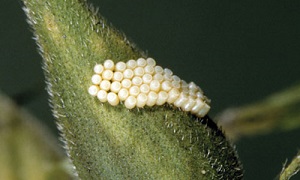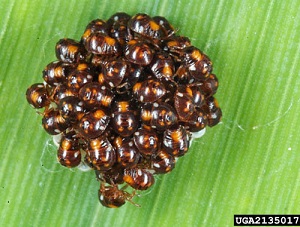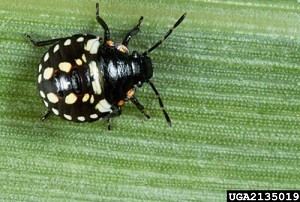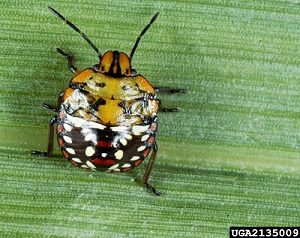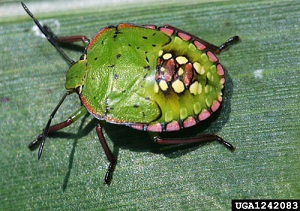| Carambola Pests | ||||||||||||||||||||||||
|---|---|---|---|---|---|---|---|---|---|---|---|---|---|---|---|---|---|---|---|---|---|---|---|---|
| Back
to Carambola Page 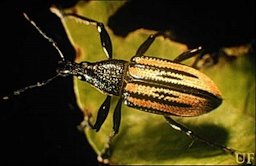 Fig. 1  Adult diaprepes root weevil, Diaprepes abbreviatus 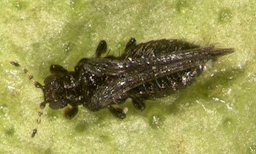 Fig. 6  Red banded thrip, Selenothrips rubrocinctus 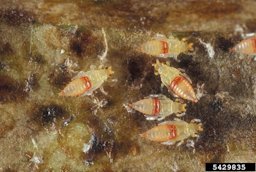 Fig. 7  Red banded thrip pupa(e)  Fig. 9  Southern green stink bug, Nezara viridula 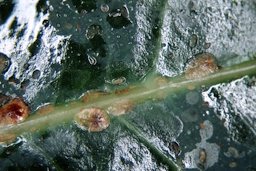 Fig. 16  Brown soft scale, Coccus hesperidum
|
Carambola trees are
attacked by a number of scale insects including plumose (Morganella
longispina) and philephedra (Philephedra
tuberculosa) scales, which attack leaves and twigs,
causing defoliation and stem dieback. The diaprepes weevil (Diaprepes abbreviatus)
causes damage to the roots, which may lead to root and shoot dieback. 1 Fruit damage caused by stink bugs (Nezara sp.) and squash bugs (Acanthocephala sp.) results in pinhole-sized markings on the fruit surface and dry areas of the flesh under the puncture wounds. This may lead to infection by fungi which cause soft rot of the fruit. Fruit blotch miner (Lepidoptera: Gracillaridae) causes a superficial damage to the waxy cuticle and can be identified by meandering brownish colored trails on the fruit surface. Brown scales (Coccus hesperidum) and red-banded thrips (Selenothrips rubrocinctus) have also been observed feeding on carambola fruit. 1 Diaprepes Root Weevil Diaprepes abbreviatus (Linnaeus) A single Diaprepes abbreviatus female can lay up to 5,000 eggs in her three to four month long life. Eggs are laid in clusters of 30 to 265 and enclosed within leaves that have been folded and glued together, or within two leaves glued together. In seven to eight days the neonate larvae emerge from eggs, leave the cluster and fall off of the leaves onto the ground. The larvae then enter the soil and search for and feed on the roots. After feeding for several months, the mature larvae pupate in the soil. Adults emerge from the soil, seek a host and mate as conspecifics gather on the host. The complete life cycle varies in time depending on nutritional and environmental factors. 2 Notching (Fig. 4) along the margins of young leaves is a telltale symptom of the presence of Diaprepes abbreviatus adults, or other related root weevils. However, other pests such as grasshoppers and caterpillars may produce similar damage. Therefore, it is best to look for a sign, such as the pest doing the damage. Look for Diaprepes abbreviatus adults during the day on the foliage. Shaking the plant may aid in detection as adults fall off of the plant onto the ground. 2 The larvae of Diaprepes abbreviatus are found in the soil where they feed on the roots of the host (Fig. 5). They will often girdle the taproot, impeding the ability of the plant to take up water and nutrients resulting in plant mortality. In addition, this type of injury provides an avenue for root rot infections by Phythophora fungus. Young hosts can be killed by a single larva, while several larvae can cause serious decline of older, established hosts. Because larvae are below ground, it is difficult to detect them before decline of above ground portions of the host is observed. 2
Fig. 2. Egg mass of Diaprepes abbreviatus, on citrus leaf Fig. 3. Young (right) and older (left) larvae of the diaprepes root weevil Fig. 4. Damage notching on leaves Fig. 5. Damage to citrus tree roots Further Reading Diaprepes Root Weevil, University of California pdf Diaprepes root weevil, Diaprepes abbreviatus (Linnaeus), University of Florida pdf Red Banded Thrip (Fig. 6) Selenothrips rubrocinctus In Florida, this species is found from Key West to Macclenny (Baker County in north Florida), but more generally it is found from the Orlando area south. The larvae and adults feed on the foliage and the fruit by piercing the epidermis with their mouth parts. Redbanded thrips prefer young foliage and their feeding and causes leaf silvering, leaf distortion, and leaf drop. The thrips destroys the cells on which it feeds, causes some leaf distortion, injury to the fruit, and leaves unsightly dark colored droplets or blotches of excrement on the leaf surface. A more serious injury is leaf drop, which may denude trees. Honeydew excretory products from red-banded thrips and other insect infestations fall to leaves, fruits or objects beneath, giving rise to the objectionable fruit-degrading, black sooty mold. 3
Fig. 8. Typical thrips damage Further Reading Redbanded Thrips, Selenothrips rubrocinctus, University of Florida pdf Southern Green Stink Bug Nezara viridula (Linnaeus) The southern green stink bug has piercing-sucking mouth parts. The mouth consists of a long beak-like structure called the rostrum. Salivary fluid is pumped down the salivary duct and liquefied food is pumped up the food canal. All plant parts are likely to be fed upon, but growing shoots and developing fruit are preferred. Attached shoots usually wither or, in extreme cases, may die. The damage on fruit from the punctures is hard brownish or black spots. These punctures affect the fruit's edible qualities and decidedly lower its market value. Young fruit growth is retarded and the fruit often withers and drops from the plant. Biological control: Parasites, usually wasps and flies, provide biological control of the southern green stink bug. In Florida a tachinid fly, Trichopoda pennipes, parasitizes adults and nymphs; and a wasp, Trissolcus basalis, parasitizes eggs. 4
Fig. 10. Eggs of the southern green stink bug Fig. 11. 1st instar nymphs Fig. 12. Second instar Fig. 13. Third instar Fig. 14. Fourth instar Fig. 15. Fifth instar Southern Green Stink Bug, Nezara viridula (Linnaeus), University of Florida pdf Soft Brown Scale (Fig. 16) Coccus hesperidum The scale body is flat and oval, light brown to yellowish in color with brown stippling, and 2.5 to 4 mm long (Fig. 16). This scale gives birth to pale yellow crawlers. Males are uncommon. Soft brown scales secrete large amounts of honeydew and the adjoining foliage becomes heavily coated with sooty mold. On occasions young citrus trees can be killed by high populations of soft brown scale from feeding and honeydew production. Scale feeding on older trees results in reduced tree vigor, twig dieback, reduced yields, and lower fruit grades due to heavy sooty mold. Soft brown scale can be found infesting a wide range of ornamental plants. The scale is heavily parasitized by several different species of parasitic wasps. 5 Further Reading A guide to Scale Insect Identification, University of Florida pdf Further Reading Growing Carambola in the Florida Home Landscape, University of Florida pdf |
|||||||||||||||||||||||
| Bibliography 1 Crane, Jonathan, H. "Carambola Growing in the Florida Home Landscape." Horticultural Sciences Dept., UF/IFAS Extension, HS12, Original pub. Aug. 1981, Revised Apr. 1994, Aug. 2005, May 2007, and Nov. 2016, Reviewed Dec. 2019, AskIFAS, edis.ifas.ufl.edu/mg269. Accessed 28 Jan. 2014, 21 Apr. 2017, 5 Nov. 2020. 2 Weissling, T. J., et al. "Diaprepes Root Weevil, Diaprepes abbreviatus (Linnaeus) (Insecta: Coleoptera: Curculionidae)." Entomology and Nematology Dept., UF/IFAS Extension, EENY-024 (IN151), Original pub. Feb. 1998, Revised Nov. 2012 and June 2022, AskIFAS, edis.ifas.ufl.edu/in151. Accessed 2 Oct. 2014, 10Sept. 2020, 5 Nov. 2020. 3 Denmark, H. A., and D. O. Wolfenbarge. "Redbanded thrips Selenothrips rubrocinctus (Giard)." Entomology and Nematology Dept., UF/IFAS Extension, EENY-099, Original pub. June 1999, Revised Feb. 2019 and June 2022, AskIFAS, edis.ifas.ufl.edu/in256. Accessed 21 Apr. 2017, 10Sept. 2020, 5 Jan. 2024. 4 Squitier, Jason M. "Southern Green Stink Bug, Nezara viridula (Linnaeus)." Entomology and Nematology Dept., UF/IFAS Extension, EENY-016 (IN142), Original pub. Nov. 1997, Revised Jan. 2007, Oct. 2010, Nov. 2013, and Jan. 2017, Reviewed Apr. 2020, AskIFAS, edis.ifas.ufl.edu/in142. Accessed 21 Apr. 2017, 10Sept. 2020, 5 Jan. 2024. 5 Futch, S.H., et al. "A Guide to Scale Insect Identification." Horticultural Sciences Dept., UF/IFAS Extension, HS-817, Original pub. July 2001, Revised Apr. 2009, and Apr. 2018, AskIFAS, edis.ifas.ufl.edu/in142. Accessed 21 Apr. 2017, 10Sept. 2020. Photographs Fig. 1,6 Giblin-Davis, R. M. "Adult diaprepes root weevil, Diaprepes abbreviatus (Linnaeus) and Red Banded Thrip, Selenothrips rubrocinctus." Featured Creatures, entnemdept.ufl.edu. Accessed 28 Jan. 2014. Fig. 2 Butler, Jerry F. "Egg mass of Diaprepes abbreviatus (L.), on citrus leaf." UF/IFAS Extension, AskIFAS, edis.ifas.ufl.edu. Accessed 2 Oct. 2014. Fig. 3 Grub, Peggy. "Young (right) and older (left) larvae of the diaprepes root weevil, Diaprepes abbreviatus (Linnaeus)." USDA, AskIFAS, edis.ifas.ufl.edu. Accessed 2 Oct. 2014. Fig. 4 Pena, Jorge. "Damage, notching on leaves - by Diaprepes abbreviatus (L.)." UF/IFAS Extension, AskIFAS, edis.ifas.ufl.edu. Accessed 2 Oct. 2014. Fig. 5 Pena, Jorge. "Damage to citrus tree roots by Diaprepes abbreviatus (L.)." UF/IFAS Extension, AskIFAS, edis.ifas.ufl.edu. Accessed 2 Oct. 2014. Fig. 7 Buss, Lyle J. "Red Banded Thrip Pupa(e)." UF/IFAS Extension, AskIFAS, edis.ifas.ufl.edu. Accessed 2 Oct. 2014. Fig. 8 Castner, J. "Typical thrips damage." UF/IFAS Extension, AskIFAS, edis.ifas.ufl.edu. Accessed 28 Jan. 2014. Fig. 9 Castner, J. "Adult Southern Green Stink Bug, Nezara viridula (Linnaeus)." UF/IFAS Extension, AskIFAS, edis.ifas.ufl.edu. Accessed 28 Jan. 2014. Fig. 10 Castner, J. "Eggs of the Southern Green Stink Bug, Nezara viridula (Linnaeus)." UF/IFAS Extension, AskIFAS, edis.ifas.ufl.edu. Accessed 2 Oct. 2014. Fig. 11,12,13,14,15 Pilcher, Herb. "Lyfe cycle of the Southern green stink bug, Nezara viridula (Linnaeus)." USDA-ARS, AskIFAS, edis.ifas.ufl.edu. Accessed 2 Oct. 2014. Fig. 16 Cranshaw, Whitney. 'Brown soft scale (Coccus hesperidum) Linnaeus." Colorado State University, 2003, Bugwood.org, (CC BY 3.0 US), bugwood.org. Accessed 25 Apr. 2016. Published 1 Oct. 2014 LR. Last update 5 Jan. 2024 LR |
||||||||||||||||||||||||
